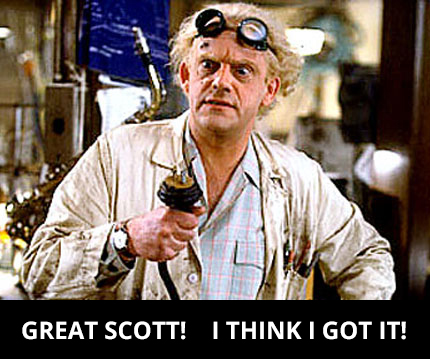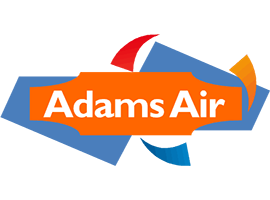"What's the difference between Power and Energy?"
When we think of efficiency, most of us think in terms of cost, and find ourselves thinking: "This piece of equipment has the highest efficiency rating and therefore will cost me the least amount of money to operate in my home and will therefore save me money". But the truth is, it's important not to confuse efficiency labels with cost efficiency because in reality these are often two complete different concepts, and that's because energy can come in many different forms, all of which vary in cost. For example: Even if you have the most efficient HVAC system in the world installed within your home, if that HVAC system is using a source of energy that costs a lot of money (Such as Propane or Electricity), then even though your HVAC system is super efficient, you're unfortunately still going to end up paying more to operate the machine, simply because the cost of propane and electricity is so high.
One thing is for certain though when it comes to HVAC equipment operation, and that is the fact that electricity is always involved - All HVAC equipment converts electricity into energy in order to do it's job, and unless your getting your electricity for free, your HVAC equipment is going to have a big impact on your electric bill at the end of the month. Therefore, one of the first things we need to do before we start discussing energy efficiency ratings, is discuss energy by explaining what it is, what it isn't, and the difference between electricity, power, and energy.

But just what is electricity and energy, and why does HVAC equipment use so much of it?
HVAC systems are complex machines that essentially use energy (Such as electricity) in order to transfer more energy (Heat) from one place to another - It all boils down to energy! When you turn your air conditioner on (Cooling mode), electricity gets converted into energy in order to operate the air conditioner's components - Fan motors convert electricity into energy that begins to rotate fan blades, compressors energize and also convert electricity into energy that allows them to compress and pump refrigerant throughout your HVAC system, and suddenly through the combined efforts of all these components that make up your HVAC system, the entire system begins to transfer energy in the form of heat, outside of your home, which in turn makes your home feel cooler on the inside.
Heaters are a little different than air conditioners, and typically have a few more options when it comes an energy source because creating heat in your home (Burning wood, gas, ect) is much easier than transfering heat out of your home like we do with an air conditioner - Instead of transfering heat in or out of your home like an air conditioner does by using a refrigerant, heaters can be set up in a way that they convert heat energy directly out of other sources of energy, including electricity, gas, wood, and so on. This energy source, in whatever form it may come in, is converted into heat by your furnace (Usually by igniting the energy source, thus converting it to heat), and the HVAC system then transfers and blows this heat into your home, and soon your home gets warmer.
This means that all HVAC equipment transfers energy in the form of heat from one place to another, and it also means that in order for an HVAC system to transfer this energy in the form of heat in and out of your home, it requires, well, energy! So it's important to point out that, energy can come in many different forms, and HVAC systems can make use of these many different forms of energy to transfer even more energy in the form of heat, into or out of our homes. This all means that, since there are many different forms of energy that HVAC systems can use, there are equally as many different energy efficiency ratings used to describe the energy savings these systems achieve. One thing remains constant though, and although HVAC systems can make use of many different sources of energy in order to do their job, they all ultimately transfer energy in the form of heat, and we can measure heat energy in BTUs (British Thermal Units).
If you've read the previous article on measuring Heat, Transferring Heat, and how the British Thermal Unit (BTU) is the standard way we measure units of heat energy in the US, you may have recall the last section of the article where we discussed how air conditioners move heat from one place to another over time, which we call "Tonnage", or Air Conditioning Power.
Tonnage of Air Conditioning is Air Conditioning Power, that is to say, it's the amount of heat energy the piece of HVAC equipment can transfer in 1 day, and it's actually based off the amount of heat energy that is required to melt giant 1 ton blocks of ice in 24 hours.
That is to say: A 1 Ton air conditioner transfers the same amount of heat in 24 hours that is required to melt a 1 ton block of ice in 24 hours, and a 2 ton air conditioner transfers the same amount of heat that is required to melt 2 tons of ice, and so on.
So it's no wonder that since we are dealing with melting such huge blocks of ice, and transferring huge amounts of energy, that our HVAC equipment also makes up a huge portion of our utility bills.
Now that we understand just how much energy our HVAC equipment transfers in and out of or homes and offices, it's only due time that we finally figure out how to calculate the cost of electricity and how much energy our HVAC equipment uses.

Have you ever wondered how much money you spend on gas per mile that you drive?
Think of it like calculating fuel mileage in your vehicle, except taking it a step further by calculating how much money you spent per gallon that you drove - You first need to know how many miles you drove per gallon, right? Then you need to know how much money each gallon costs, and you can use a simple calculation to determine how much you spent to drive each mile.
We're going to be doing the same sort of thing with our HVAC equipment, but instead of vehicles, fuel mileage, and cost per gallon, we're going to instead talk about HVAC equipment, electric bills, and kilowatt hours.
To nerd or not to nerd, that is the question.
Now, electricity can be definitely be confusing to understand at first, but that's because just like heat, it's invisible, and when trying to understand electricity it's very common to confuse terms such as Amps, Volts and Watts with each other, especially if we don't have a good understanding of what each of terms refer to when it comes to electricity.
But instead of nerding-out on electricity (which we could dedicate an entire article to) we're going focus on how electricity is used by HVAC equipment and converted into energy, how it's measured, and how electric companies formulate our utility bills. After all, we don't need a complete understanding of electromagnetism in order to make use of electricity, turn our thermostats down, or understand we have an electric bill we have to pay at the end of the month, now do we?
If you're one of those people who find electricity super fascinating and want to dive deeper into the subject, and learn more than what we're going to be discussing in this article, we definitely recommend checking out the following links for more in depth information on electricityd:
Understanding Energy and Power
Other wise, right now we need to understand our air conditioners use energy, and a lot of it, and certain efficiency ratings that we will get into later, such as EER (Energy Efficiency Ratio) and SEER (Seasonal Energy Efficiency Ratio), are all efficiency ratings that describe energy savings, which is to say they also describe cost savings. But, before we move onto energy savings and efficiency ratings, let's start with how much it costs to run our HVAC equipment and go over a few basic concepts we will be using from here on out.
If you've ever looked at your electric bill, you may have noticed that the electric company charges you based on Kilowatt Hours of energy used, or kWh, which means we need to somehow figure out how much energy, or Kilowatt Hours worth of energy our HVAC equipment is using. But, what is energy?
Electricity is not energy, and energy is not electricity.
Energy comes in many forms, some popular forms of energy include: Joules, Calories, BTUs, and Kilowatt Hours.
When we eat food and our bodies convert the food into a form of energy known as Calories.
When an air conditioner transfers heat energy in and out of your home, it's transferring energy measured in BTUs, and when electric appliances (including air conditioners) operate, they convert electricity into energy which is measured in Kilowatt Hours.
As mentioned earlier, the electric company just so happens to charge us based on Kilowatt Hours worth of energy used, but what is a Kilowatt Hour? And how did they come up with this bill anyway?
In order to understand what a Kilowatt Hour is, and how many Kilowatt Hours worth of energy our HVAC equipment uses, we first need to go over the basics of electricity and understand what Amperage, Voltage, and Wattage are, and how we can convert these 3 things into energy such as Kilowatt Hours (which the electric company bills us for using).
 So, the electric company produces electricity with a generator, and sends the electricity down a power line into your house which provides electricity to all the electrical appliances in your home, including the air conditioner, which converts this electricity into energy in order to operate all the electrical components that lend a hand in the process of transferring heat in or out of your home over a period of time.
So, the electric company produces electricity with a generator, and sends the electricity down a power line into your house which provides electricity to all the electrical appliances in your home, including the air conditioner, which converts this electricity into energy in order to operate all the electrical components that lend a hand in the process of transferring heat in or out of your home over a period of time.
The electric company monitors how much energy your entire home uses with an electric meter that measures how much energy your entire home uses over a period of time based in units of energy called Kilowatt Hours, which, unlike the name suggests, is not the number of Kilowatts your home is using in an hour.
A Kilowatt (not to be confused with a Kilowatt Hour) is simply 1000 Watts, and a Watt is a measure of power, but the electric company charges us based on energy use, which means there is a difference between power and energy which often gets us confused.
So what's the difference between Power and Energy?
The easiest way to explain the difference between power and energy is by comparing power and energy to speed and distance.
Energy
Power
Distance
Speed
We all understand speed and distance, right? For example, if you drive at a constant speed of 60 miles per hour for one hour, then you will have traveled a distance of 60 miles. That is to say, speed is the rate at which you travel a distance, easy right? And it takes time in order to travel a distance right? We can't just instantly appear 60 miles away from where we are right now without applying a rate of speed to our efforts to get there, right?
Now, lets think of Power and Energy in the same way we think of Speed and Distance.
We measure Speed in Miles Per Hour, and we measure Distance in Miles.
We measure Power in Watts, and we measure Energy in Kilowatt Hours.
In the same way that you travel 60 miles per hour for an entire hour, and end up traveling a distance of 60 miles, you may have a hair drier that needs 1000 watts of power to make it work, and if you ran that hair drier for an entire hour, it would have then used 1 Kilowatt Hours worth of energy.
Likewise, you may also have a smaller appliance, such as a lamp, that only needs 100 watts of power in order to work, which means that if you left the lamp on for 10 hours, the lamp would finally have used 1 kilowatt hours worth of energy.
So, Power is measured in Watts, and is describing how fast something is using energy, kind of like how Speed is measured in Miles Per Hour and tells us how fast we travel a Distance.
Energy is measured in Kilowatt Hours, and is what gets used over a period of time based on the power of an electrical appliance, kind of like how distance is what gets traveled over time based on the speed we drive our vehicles.
The word "Watts" is kind of a deceptive word to use for describing power, isn't it? What's a Watt, anyway? The word "Watts" tells us absolutely nothing about what it's actually referring to in terms of measurement, there's no mention of "Power" or "Energy", and it hints to nothing about Time, and that's because "Watts" is actually some wise guys last name who thought about this stuff a long time ago, and thus the concept of Watts as a measurement of Power was born and here we are stuck using it.. Or, are we?
Isn't it just like 50x easier to understand a concept when it's spelled out for us, like "Miles Per Hour"? It's much easier to wrap our brains around the concept of Speed when it's all spelled out for us with a term like "Miles Per Hour", right?
When we examine the concept of Miles Per Hour, we can easily see from the way it's written and structured that "Miles" is the distance we are concerned with traveling, and "Hours" is the rate at which we are concerned with traveling it. What was Watt thinking? That's just the way the imperial system works, it's based off of old school family names, and the sizes of kings feet. But if your anything like me, this sort of structure is confusing, so what if we just used the SI method of measuring Power instead?
Introducing Joules Per Second
In the same way that we understand Miles Per Hour, it's also much easier to think of Watts, as Joules per Second, or J/s for short, and in fact they are the exact same thing. Joules is the SI measurement for a single unit of energy, and energy divided by time is: Power. Just like Distance divided by time is: Speed.
The electric company may not measure energy in Joules (They measure energy in Kilowatt Hours), but that's OK too, because 1 Joule Per Second just so happens to equal 1 Watt. Nice.
Joules Per Second is a nice and clear unit of power that makes it obvious that power is the rate at which energy is being used. It's just like how Miles Per Hour makes it very obvious that speed is the rate at which distance is being traveled.
So if the term Watts confuses you, just try replacing it with Joules per Second, they are the exact same thing, and you wont be making any errors (you'll just be using two different forms of measurement) and it will probably help your brain recognize the fact that when it comes to Power that your dealing with a rate at which energy gets used because it's spelled out for you in the way the unit is written.
So, with that in mind, lets re-phrase our previous hair drier example using Joules per Second instead of Watts, and see how much easier it is to understand: You may have a hair drier that needs 1000 Joules Per Second worth of power to make it work, and if you ran that hair drier at a constant rate of 1000 Joules Per Second for 1 hour, you would have then used 1 Kilowatt Hours worth of energy.
And if we once again convert our example back into a speed and distance analogy, we get: You may be sitting in a taxi that's traveling 60 miles per hour, and if the taxi travels at a constant rate of 60 miles per hour for 1 hour, you would have then traveled 60 miles.
Since cost is something that is accrued over a period of time, and Kilowatt Hours is a unit of energy usage measured over time (1000 watts used consistently for 1 hour), the electric company bases your bill off of Kilowatt Hours worth of Energy, not Watts of Power (Joules per Second).
It's the same for a taxi company: A taxi company charges you based on the distance you travel, not the speed at which you traveled a distance, right?
Let's take a little quiz, and see if the difference between Power and Energy is starting to reveal itself to you yet.
Pop Quiz: How long does it take to use 1000 watts?

Bzzz! Don't answer that! It's a trick question!
That's like trying to answer this question: How long does it take to travel 60 miles per hour?
It doesn't make any sense, does it?
Sorry to trick you, but there is a point to this mischief - That trick question is a question only someone would answer if they didn't understand the difference between Power and Energy, and seeing the difference between Power and Energy in the way we phrase words helps our brains understand the vital differences between Power and Energy.
Let's jump back to our speed and distance analogy and compare it to power and energy again for a better understanding:
1) 60 Miles Per Hour isn't a distance, so we can't refer to it as though it is, but driving an hour at 60 miles per hour translates into a distance traveled, so we can.
2) A taxi company doesn't charge you based on the speed at which you get to your destination, they charge you based on the distance you and the taxi driver travel.
3) So, in the same way it doesn't make sense to ask: "How long does it take to travel 60 miles per hour?", it also doesn't make sense to ask: "How long does it take to use 1000 Watts (1000 Joules per Second)?".
4) Now, on the other hand it does make sense to ask: "How long does it take to drive 60 miles in 1 hour", right? And, therefore it also makes sense to ask "How long does it take to use 1 Kilowatt Hour?".

So, if it takes 1000 watts (1000 Joules Per Second) to power on your hair drier and turn it on, that means if you ran your 1000 Watt hair drier for exactly 1 hour, then it has used 1 Kilowatt Hours worth of energy. That is to say: A Kilowatt Hour is equivalent to a an appliance, such as a hair drier, using 1000 watts of power constantly for 1 whole hour.
Just like 60 miles is equivalent to a taxi driving at 60 miles per hour for 1 whole hour.
Now, since a Kilowatt Hour is the basic unit of energy the electric companies charge us for using energy, this means they have a base rate they charge us for using a Kilowatt Hour. Which is to say, they charge a set rate per hour of energy used constantly at 1000 Watts (1000 Joules per Second).
The same applies to a taxi company doesn't it? Taxi companies charge you per mile of distance traveled. And, like taxi companies have a base rate for miles traveled, electric companies also have a base rate they charge per Kilowatt Hour used, which for example may be $.10 cents per Kilowatt Hour worth of energy used. Based on this example, if you use 1000 Kilowatt Hours worth of energy in a single month at a cost of $.10 cents per Kilowatt Hour, your electric bill would be a total of $100.00.

Wattage (Joules per Second) then, which is used to describe Power, is the total amount of work an electrical current can do, and since power indicates a quantity of something multiplied by a rate of something, when it comes to electricity then the way we calculate Wattage (Power) is by multiplying Voltage (Quantity) by Amperage (Rate).
Now let's switch gears and talk about Electricity for a brief moment:
Amperage and Voltage are electrical measurements referring to the building blocks of electricity known as Electrons and the Electromagnetic Field they create. We can measure these characteristics of these physical particles that move around when electricity is flowing through power lines, and we can also measure the Electromagnetic Field they inversely create as they do so. So, Amperage and Voltage only describe what electrons and the electromagnetic field are doing, but since electrons and their behavior can be measured and translated into power and energy, we have to measure their behavior in order to see just how much power and energy is present in a wire.
That is to say, there is both an amount of electromagnetic field difference (Volts), and a rate at which the electrons are flowing (Amps), and when we multiply them together (Volts X Amps) we get their power (Watts).
Now, this is where our Taxi car analogy starts to break apart and no longer makes sense, so for the sake of simplicity, let's skip all the technical mambo-jumbo and just compare Electrons, Amperage, Voltage, Watts, Joules, and Kilowatt Hours to a Bank, Money, and a bunch of People spending all of their money at a Casino, and let's tie everything all together, shall we?
The Casino Analogy:


1) Think of the Generator that the power company uses to generate electricity as the Bank in our analogy, and think of Energy that the generator produces as the Money inside of the Bank.
2) Now, think of Electrons as the People traveling to and from the Bank and the Casino.
3) Finally, think of the Air Conditioner as the Casino in our analogy.
Now lets put our analogy together:
People (Electrons) pick up money (Energy) from the bank (Generator) and spend the money (Energy) at the casino (Air Conditioner), and then go back to the bank for more money, and then go back to the Casino and spend it all over again. This process essentially keeps the casino (The Air Conditioner) in operation, and once the people stop carrying money (energy) to the casino (air conditioner), it quickly shuts down. How long the casino stays in operation, or rather, how much money the casino makes over a period of time is what we're trying to count when it comes to calculating Kilowatt Hours, Joules, and the Cost of Energy Usage.
Simple, right? Let's break down our analogy and insert the concepts we need to understand in order to start calculating energy costs ourselves:
Amperage
| Amperage is the speed, or rate at which the electricity is flowing per second. Just like your car can travel 60 miles per hour, Amperage is indicating how much electricity is passing through the air conditioner per second. When we compare this to our casino analogy, it's how fast the people are moving through the casino. |
Voltage
| Voltage is the amount of electricity without any reference to it's speed or rate, and in our casino example, it's how much money each person is carrying. |
Wattage
| Wattage is Electrical Power, or the combination of both the Amperage and the Voltage when they are multiplied together (Amps x Volts). In our casino example it is the amount of money the people are spending at the casino. |
Joules
| Joules (Not to be confused with Joules Per Second) are tiny and singular units of energy, and in our casino example, they are a single dollar bill - If a person in our example is carrying 100 dollars, they are carrying 100 Joules of Energy. |
Calculating Wattage
So, if 10 people pass through the casino in a single second and each spend $100 dollars, how much money was spent in 1 second by all 10 people? 10 x $100 = $1000, or $1k a second. Thats Power (and a great profit, too), and in electrical terms it's called Wattage. When we have 10 volts traveling at 100 amps through an appliance such as an air conditioner, we have 1000 watts worth of power, and since a Kilowatt is made up of 1000 Watts, this means that at 1000 Watts we have exactly 1 Kilowatt worth of power. Simple, right?

Understanding Kilowatt Hours
Now, what if this whole process of making $1000 dollars each second happened for an entire hour? What if we wanted to call this hour long process something, and we just call it, "$1000 Dollar Hours"? That's Kilowatt Hours. An appliance that uses 1000 watts of power consistently for an entire hour, uses 1 Kilowatt Hour worth of energy.


Calculating Joules
What if we wanted to know exactly how much money a $1000 Dollar Hour actually equals? In other words: How much money is our casino actually making from a $1000 Dollar Hour? Isn't this basically like asking: How much money does our casino make at $1000 dollars a second accrued each second for an entire 1 hour period?
Yep, so lets do it:
If our casino is making $1000 a second, and there are 60 seconds in a minute, this means our casino is making $60,000 a minute (must be nice).
And, if our casino is making $60,000 a minute, and there are 60 minutes in an hour, then our casino is making $3,600,000 an hour.
The same thing applies to Joules of Energy, which are the basic SI single units of energy, and in our casino analogy, it is a single dollar.
So, if our air conditioner is powered with 1000 watts (1000 Joules Per Second), and operates for 60 seconds, then our air conditioner has used 60,000 Joules of energy.
And, if our air conditioner is using at 60,000 Joules of energy each minute, and there are 60 minutes in an hour, then after 1 hour our air conditioner would have used 3,600,000 Joules of energy, which is exactly 1 Kilowatt Hours worth of energy.

Final Thoughts on Electricity, Power and Energy
So now hopefully we have a good understanding of Power and Energy and more importantly, the difference between the two. From here-on-out we're going to be making a bunch of references to energy and power as we begin to discuss the differences between the many different HVAC energy efficiency ratings out there, so it's definitely important to recognize the difference between the two and in order to understand how our HVAC equipment is saving us energy, and in turn how a specific energy efficiency rating works in order to save us money.
Remember, energy can come in many different forms, and HVAC systems essentially all make use of energy in one form or another (electricity, natural gas, wood, oil, or propane) in order to transfer energy in the form of heat, in and out of our homes. From now on, each of the efficiency ratings we're going to be discussing should be looked at in one way or another as a description of a percentage of energy that is being saved during a piece of HVAC equipment's operation, whether it be energy being utilized in the form of electricity, or in the form of natural gas, or in any other form.
The important thing to remember is, utility companies charge us based on our energy consumption, therefore, the more energy we can save, the less our utility bills cost. Unfortunately, the way energy consumption is defined can be split up into many different terms, and this is especially true when it comes to the energy we consume from the electric company. But, in the simplest of terms we can always convert energy into terms of Joules, so if thinking in terms of Joules makes understanding energy easier, then you can always convert whatever form of energy we are discussing into Joules, because although energy may come in many different forms, it's all essentially energy, and that means it can always be converted and understood as Joules.
- Remember: Energy comes in many different forms, from electricity, to heat, to natural gas, and even calories in our food!
- HVAC systems use many different forms of energy in order to transfer energy in the form of heat, into or out of our homes. But, no matter what form of energy and HVAC system is using in order to perform work, all energy can essentially be converted and broken down into Joules as a basic fundamental form of describing energy, which makes understanding Energy much easier.
- The factors that affect actual HVAC energy consumption are: Everything!





